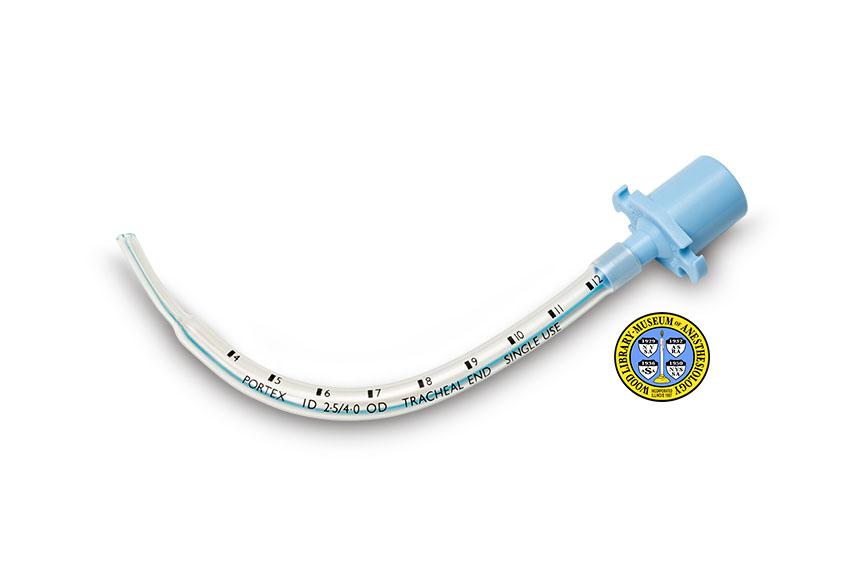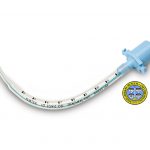Cole Tracheal Tube
The Cole Tracheal Tube was introduced by anesthesiologist Frank Cole, M.D. (1909-1982), in 1945, when endotracheal anesthesia in infants and young children was still uncommon. Endotracheal anesthesia refers to the administration of anesthetic gases through an endotracheal tube (breathing tube) that has been inserted through the mouth, or nose, and into the trachea (windpipe).
Endotracheal tubes for infants need to be very narrow in diameter in order to fit through the larynx (the part of the respiratory tract that contains the vocal cords, located just below the opening to the lungs and just above the trachea). Narrower tube diameters cause more resistance to the flow of air through the tube, and can increase the work of breathing. Dr. Cole created his endotracheal tube so that it was narrowest only where it had to be: through or below the larynx. The portion of the tube that remained above the larynx could be larger in diameter. The part of the tube with a larger diameter also helped to prevent the tube from being inserted too far.
In 1957, Dr. Cole proposed a formula to estimate the best endotracheal tube size for a pediatric patient. A modified version of the formula is still in use today.
Catalog Record: Cole Tracheal Tube
Access Key: altf
Accession No.: 2005-01-19-3 A
Title: Tracheal tube : Cole tube.
Author: Cole, Frank, 1909-1982.
Title variation: Alt Title
Title: Cole tracheal tube.
Title variation: Alt Title
Title: Cole endotracheal tube.
Publisher: Keene, New Hampshire : Concord/Portex, [1989?].
Physical Descript: 1 endotracheal tube : plastics ; 3 x 2 x 16 cm.
Subject: Intubation, Intratracheal – instrumentation.
Subject: Airway Management Equipment.
Subject: Airway Management – instrumentation.
Subject: Anesthesia, Intratracheal – instrumentation.
Subject: Anesthesia, Pediatric – instrumentation.
Note Type: General
Notes: The date range is based on the earliest dates in which the exact form of the
name “Concord/Portex” was found and on what appears to be a date on the
packaging that accompanies the tube, “”REV. 8/89”. The earliest 510(k) FDA
application by “Concord/Portex” this cataloger found was submitted on
“3/13/1989”. Also, in a Google Books search performed, the earliest reference
to the exact form of the name “Concord/Portex” was in a 1989 issue of Health
Devices. These searches were performed on March 17, 2015. The date range
could change if documentation that indicates the dates should be corrected is
discovered.
Note Type: General
Notes: The title was taken from the packaging.
Note Type: Citation
Notes: Bennett EJ, Bowyer DE. Neonatal anesthesia. Principles of Pediatric
Anesthesia. Springfield, Illinois: Charles C Thomas, Publisher; 1982:197.
Note Type: Citation
Notes: Cole F. A new endotracheal tube for infants. Anesthesiology. 1945;6(1):87-88.
https://anesthesiology.pubs.asahq.org/article.aspx?articleid=1972706. Accessed
April 22, 2015.
Note Type: Citation
Notes: Cole F. Pediatric formulas for the anesthesiologist. AMA J Dis Child.
1957;94(6):672-673.
Note Type: Citation
Notes: Leigh MD, Belton MK. Anesthetic technics. In: Pediatric Anesthesiology. 2nd
ed. New York: MacMillan Company; 1960:207-208.
Note Type: Citation
Notes: Marcy JH, Cook DR. Basic neonatal anesthesia and monitoring. In: Neonatal
Anesthesia. Pasadena, California: Appleton Davies, Inc.; 1988:148.
Note Type: Citation
Notes: Randolph KA, Patel A, Tran MCJ. The history of pediatric intubation and
endotracheal anesthesia. Presented at: The Joint Annual Meeting of the
Society for Pediatric Anesthesia (SPA) and the Association of Paediatric
Anaesthetists of Great Britain and Ireland (APA); October 12, 2007; San
Francisco, CA. https://www.pedsanesthesia.
org/meetings/2007annual/syllabus/History/H5-Randolph.pdf. Accessed April 22,
2015.
Note Type: Citation
Notes: Smith RM, Rockoff MA. History of pediatric anesthesia. Smith’s Anesthesia for
Infants and Children. 8th ed. Philadelphia, PA: Elsevier, Mosby;
2011:1298-1299.
Note Type: Physical Description
Notes: One infant endotracheal tube with packaging; The measurements in the physical
description field were rounded up to the earliest half cm; The unrounded
measurements are 2.7 x 1.7 x 16 cm; The physical description of this tube
will be based on a patient perspective (i.e., the tracheal end is the
proximal end, and the external end with the connector is the distal end); The
connector is light blue and the tube is clear with a number of manufacturer
markings’; Marked on the connector is “PORTEX” and “5.0 mm”; The first 4 to 5
cm of the proximal end of the tube has a narrow diameter than the remainder
of the tube; The portion of the tube with a larger diameter is marked in
increments of one cm from 4 to 12 cms; Also marked on the tube is “PORTEX ID
2.5/4.0 OD TRACHEAL END SINGLE USE”; The packaging that accompanies the
tube is opaque with manufacturer markings on one side and transparent plastic
on the other side; The opaque side is white with blue printing and some red
stamped lettering. Beginning with the blue printed text and stamped red text,
in the upper right corner of the package, the text includes, “STYLE: [in
blue] COLE TUBE [red text, new line] CAT.NO.: [blue text] 143025 [red text,
new line] SIZE: [blue text] 2.5 MM [red text, new line] LOT. NO.: [blue text]
101431 [red text, new line]; The remainder of the text is printed in blue,
and includes, “BLUE LINE [new line] TRACHEAL TUBE [new line] PORTEX [possibly
in a logo, new line] CONCORD/PORTEX [new line] KEENE, NEW HAMPSHIRE 03431, U.
S.A. [new line] SIMS A SMITHS INDUSTRIES MEDICAL SYSTEMS COMPANY; To the
right of the PORTEX logo and company name and address, the following text is
printed, “CAUTION: [new line] FEDERAL (U.S.A.) LAW RESTRICTS THIS DEVICE TO
SALE BY OR ON THE ORDER OF A PHYSICIAN. [new line] DISPOSABLE FOR SINGLE USE
ONLY. [new line] SEE INSERT SHEET PROVIDED FOR FURTHER INFORMATION. [new
line] STERILITY: [new line] CONTENTS WITHIN THE PACKAGE ARE STERILE UNLESS
PACKAGE HAS BEEN OPENED OR DAMAGED. [new line] PB-073 REV. 8/89″.
Note Type: Reproduction
Notes: Photographed by Mr. Steve Donisch, January 12, 2015.
Note Type: Acquisition
Notes: Donated to the WLM by Charles J. Coté, MD.
Note Type: Historical
Notes: The Cole Tracheal Tube was introduced by anesthesiologist Frank Cole, M.D. (1909-1982), in 1945, when endotracheal anesthesia in infants and young children was still uncommon. Endotracheal anesthesia refers to the administration of anesthetic gases through an endotracheal tube (breathing tube) that has been inserted through the mouth, or nose, and into the trachea (windpipe).
Endotracheal tubes for infants need to be very narrow in diameter in order to fit through the larynx (the part of the respiratory tract that contains the vocal cords, located just below the opening to the lungs and just above the trachea). Narrower tube diameters cause more resistance to the flow of air through the tube, and can increase the work of breathing. Dr. Cole created his endotracheal tube so that it was narrowest only where it had to be: through or below the larynx. The portion of the tube that remained above the larynx could be larger in diameter. The part of the tube with a larger diameter also helped to prevent the tube from being inserted too far.
In 1957, Dr. Cole proposed a formula to estimate the best endotracheal tube size for a pediatric patient. A modified version of the formula is still in use today.
Note Type: Publication
Notes: Cole F. An endotracheal tube for babies. Anesthesiology. 1945;6(6):627-628.
https://anesthesiology.pubs.asahq.org/article.
aspx?articleid=1972666&resultClick=3. Accessed April 22, 2015.
Note Type: Publication
Notes: Cole F. New and practical: a new headstrap for anesthesia for carotid
arteriography. Anesth Analg. 1970;49(3):476-477. https://journals.lww.
com/anesthesia-analgesia/Citation/1970/05000/A_New_Headstrap_for_Anesthesia_f
r_Carotid.31.aspx. Accessed Apriil 22, 2015.
Note Type: Publication
Notes: Cole F. A new stethoscope for the anesthesiologist. Anesth Analg.
1954;33(2):143-144. https://journals.lww.
com/anesthesia-analgesia/Citation/1954/03000/A_New_Stethoscope_for_the_Anesth
siologist__.15.aspx. Accessed April 22, 2015.
Note Type: Publication
Notes: Cole F. A slotted endotracheal tube. Anesth Analg. 1945;24(6):263.
https://journals.lww.
com/anesthesia-analgesia/Citation/1945/11000/A_Slotted_Endotracheal_Tube__.10
aspx. Accessed April 22, 2015.
Note Type: Publication
Notes: Maxwell LG. Endotracheal tube use in children: history as pretext for current
teaching. In: Fine GF, ed. New Advances in Pediatric Ventilation:
Revolutionizing the Management of Pediatric Intubation with Cuffed Tubes.
[Roswell, Georgia?]: Kimberly-Clark; 2008:2-3. https://www.kchealthcare.
in/media/74475/clinical%20article_new%20advances%20in%20pediatric%20intubatio
_.pdf. Accessed April 22, 2015.
Note Type: Exhibition
Notes: Selected for the WLM website (noted March 17, 2015).


